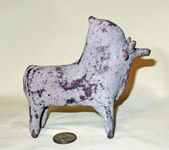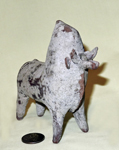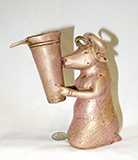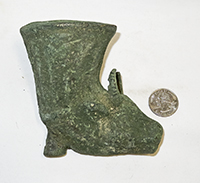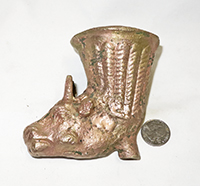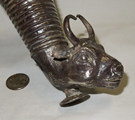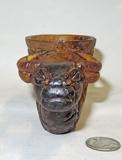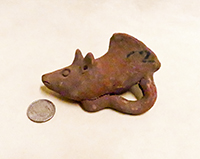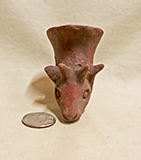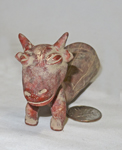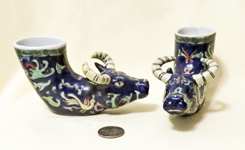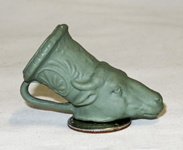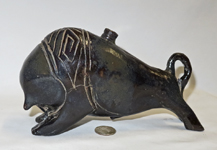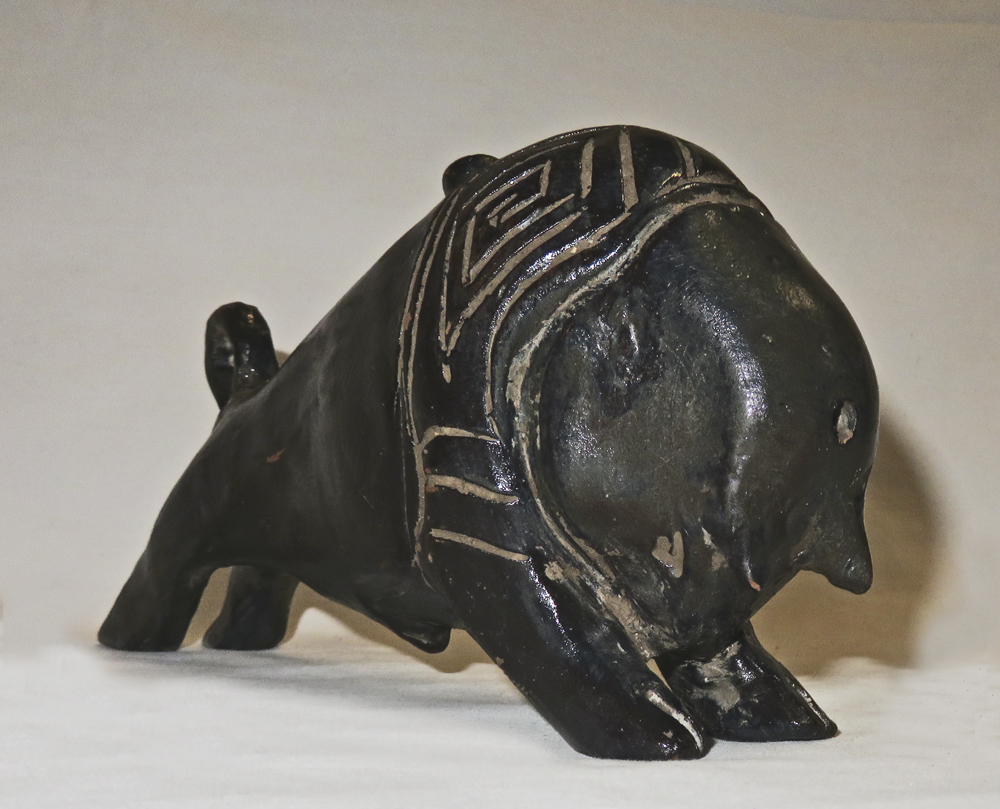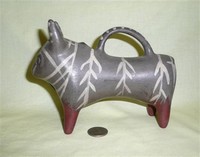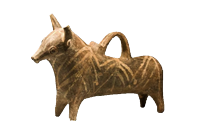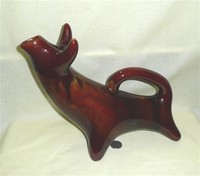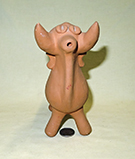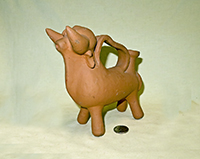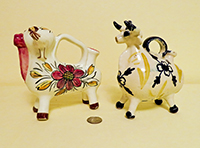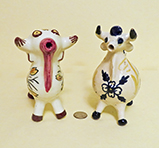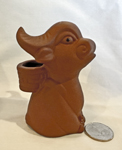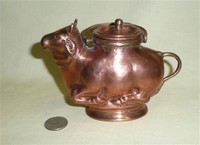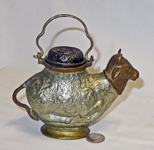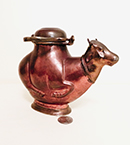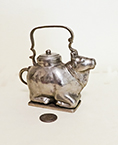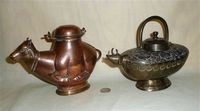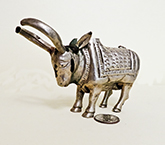Rhytons
plus Nandi and a few other liquid dispensing vessels
My Webster’s third International Dictionary defines rhyton as “an ancient Greek
drinking horn of pottery, usu. having the base in the form of the head of an animal,
woman, or mythological creature.” Wikipedia is much more expansive, stating
“A rhyton (plural rhytons or, following the Greek
plural, rhyta) is a container from which fluids were intended to be
drunk or to be poured in some ceremony such
as libation. The
English word rhyton originates
in the
ancient Greek
word ῥυτόν (rhy̆tón or rhŭtón). The conical rhyton
form has been known in the Aegean region since
the Bronze Age,
or the 2nd millennium BC. However, it was by no means confined to that region. Similar
in form to, and perhaps originating from,
the drinking
horn, it has been widespread over Eurasia since prehistoric times. (note: I saw some
great Parthian examples in a museum in Ashkabad, Turkmenistan) … Many vessels considered
rhytons featured a wide mouth at the top and a hole through a conical constriction at
the bottom from which the fluid ran. The idea is that one scooped wine or water from a
storage vessel or similar source, held it up, unstoppered the hole with one's thumb, and
let the fluid run into the mouth (or onto the ground
in libation)… Rhyta
were often used for liquids that needed straining, such as wine, beer and oil. Some
rhyta were used in blood rituals and animal sacrifice. In these cases, the blood may
have been thinned with wine. Some vessels were modeled after the animal they were
intended to be used with during ritual, but this was not always the case… Rhyta occur
among the remains of civilizations speaking different languages and language groups in
and around the Near and Middle East, such as Persia, from the second millennium BC. They
are often shaped like animals' heads or horns and can be very ornate and compounded with
precious metals and stones.” The Google ‘Images of Rhyton’ page has some 181,000
pictures, and while the majority are of the horn-shaped form, there are also many that
feature a full-bodied caracature of a cow, bull, or other creature, molded much like the
‘modern’ cow creamer or pitcher. Indeed, some of those pictures are of works from
modern artists’ (including William Morris).
This section of my collection does not include any of the vary fancy ancient (BCE) rhytons like those shown on the History page. – those are either in
museums or extremely expensive. It does however have a couple that are representative of the early ones plus a few that appear to be copies of ancient ones, as
well as modern vessels that are designed for uses similar to those for which rhytons were intended. Thus
here I include the Peruvian Toritos de Pucara, which originally were used to hold chicha and blood for the
cattle branding ceremony as described on the Places page. Probably inappropriately, I have also put here a
number of Spanish bull caricature vessels designed for wine or oil and vinegar (popular tourist items), as
well as other cow or bull caricatures that might best be termed ‘cruets’ but which have shapes somewhat
reminiscent of some of the early rhytons. And, I’ve snuck in a couple liquor dispensers and what I believe
to be an old Chinese soy pot, for lack of a better place.
More appropriately, I have added a section at the
bottom of this page for my Hindu Nandi – designed for libations of holy water in Hindu Temples devoted to
Shiva – since they, and the somewhat similar cow-headed vessels used to hold ghee to feed the holy flame, have
ritualistic purposes.
As a reminder, click on any thumbnail for a larger picture.
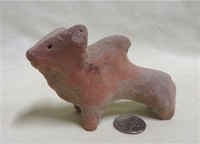 |
Well, this was sold as a rhyton, and although it has no holes it does seem to be
a cute little bull effigy. It was said to be Amlash, 1st millennium BC, and came
certified as original from an antiquities dealer
in Cyprus. It was sufficiently inexpensive as these
things go that I thought it would make a good introductory contribution to this part
of the collection. Amlash is a fairly generic term referring to a geographic region
in northern Iran, and apparently most of the artifacts
from there date to the 9th-8th century BCE. A check of the photos on
google shows that hump backed bulls seemed to be popular items for Amlash
rhytons. |
This was sold as a 'superb beautiful small terracotta Amlash bull rhyton, rare', by a company in Whitby, Canada, that had only been sellong on eBay for a couple months. It is indeed really cute, and has a hole in the snout. It is in great condition, and has a nice Amlash shape. The seller's description said it was original, but of unknown age and place of origin. Having biught it with Canadiuan dollars, I was somewhat urprised ro find whwn it arriuved that it came from Farid & Mirrwais Novelties Trading, Umm Ramool, Dubai UAE. This I'd guess its age as a couole months, and its origin as Dubai, UAE and yes it probably is rare, because I doubt they could count on selling many of these. I could of course be wrong...but as the old saying goes, you pay your money, you take your chances. Whatever...I do like it, and at least it didn't cost the umpteen thousand dollars that I have seen Amlach rhytons on offer for.
|
This, per the ebay seller MD Antiquities of the UK, is a bronze Persian rhyton circa 300BC. It came with a lot of verdigris which I decided to remove, and it looks quite nice with the bronze exposed and shiny. This bull is a very interesting and heavy bronze piece, and nicely fits the Rhyton definition since it certainly appears designed to pour a libation of come sort. The seller said they usually came in sets (a similar one was sold on eBay shortly before this one), and there would have been many around a round table. I have no experience with antiquities like this, but hope to learn more.
|
From the same UK seller camne this Persian bull head rhyton - in this case more like a drinking vessel - said to be @400 BC. It was heavily encrusted but after several days in vinegar and a bit of light brushing it came somewhat clean, nicely displaying the bronze.
|
Here's a third rhyton from MD Antiquities - said to be "circa 500BCE Ancient Persian hand beaten silver rhyton vessel". I checked it and a magnet didn't stick and the test acid left a small mark, so I believe it is indeed some form of silver, although it doesn't shine up very well. Not surprising given its age, I guess. Like the two above it came looking like it had been buried for a while - dust and dirt - but whether it is actually as advertised I really can't say for sure. This dealer starts all his prices very low so it's worth taking a chance, and indeed this is a very nicely made piece.
|
This one, also from MD Atiquities, was advertised as a museum quality ancient near eastern rock crystal rhyton vessel eiwith a bull's head. It is quite nicely carved, it certainly appears to be rock crystal of some sort (whatever that is) and came clean. Even if not completely as advertised, I feel it was well worth the $80 and is a quite different addition to the collection. I wish I know of some way to verify the nature of these things - but I think that even the dealers have trouble. Lots of things are getting smuggled out of the middle east these days, and of course folks are still making 'antiquities', so I' imagine that even experts make mistakes.?p>
|
|
The UK seller from whom I purchased this little vessel on ebay stated in his description that it is a Viking terracotta rhyton dating from around 250-350 AD, and came from a private 1970s collection of Eastern European items. It's too small to be useful for drinking (except perhaps for a very tiny Viking) and is unglazed so not really suitable for liquids meant to be consumed. He also stated that it's unusual in that it bears a fertility symbol (which I have been unable to locate). But then, he also said exactly the same thing about a similar gost's head piece, so I am beginning to doubt all the above. And, later he advertised an identical piece with another story, so it seems it's a modern fake. Nonetheless, it was very affordable and sorta looks like a 'drinking' rhyton...and it's fairly interesting in its own right, if crude. |
This one is, to my mind, quite cute. It was described on Ebay as "Ancient Persian Terracotta Rhyton Vessel with bull head, Rare", from a seller said to be in Hing Kong. It was mailed to me from New York. OK...I'd give it about a 3% probability of being as advertised. If it is, great. No way that I know of to verify...but then I didn't expect a lot, just thought the shape and round ears and stubby front legs were interesting. It doesn't take a lot of room on the shelf. |
|
|
This one came from the same Hong Kong seller as the one just above. It's also just as unlikely to be Ancient Persian as advertised - but I assume someone had fun making it. It was cheap enough and interesting enough that in spite of almost certainly being a fake or rather reproduction, I decided to get it. |
>
I got the cloisonne-like drinking rhyton on the left a number of years ago from an Enlish seller who thought it was Chinese. Then the two on the right cane up on eBay and I guess I didn't compare well enough because it turns out that they are the same as the other one, only with a dark blue background. The English seller of these said she got them at an auction in Workingham, Berkshire around 2003 and that the auictioneer said they had belonged to a merchant mariner and he thought they were Persian. Whatever...they are quite lovely and make a nice addition to the colelction.
|
|
Here is another drinking horn or rhyton, this one a very special dollhouse cow or rather bull, more modern than the ancient ones but with a bit of age nonetheless (It is also featured on the Miniatures page). The English seller acquired it at a "very fanous" toy and doll auction, where the specialist informed her it was Edwardian, made by Wedgewood. The jasper coloration and beautiful molding certainly attests to that origin. Doll houses were very populaer in that era which is what likely induced Wedgewood to enter the game(the seller has a few others by them from the same coillection and auction, but this was the only cow/bull). |
This massive bull was sold as a "Celtic ritual rhyton Viking Bull AD 200-400". The interlocking diamonds on its shoulders do seem to match the description. It came to me from an antique dealer in Ebbs Austria who seems to largely specialize in coins. He kindly told me that he acquired it from the heirs of a serious collector from Munich, Germany who had bought it in an antique shop in Oslo, Norway. It is interesting in that it has both a raised fill hole, and a pour hole...in its forehead. I tried if and it does pour, albeit a bit sloppily. Perhaps it was intended for a ritualistic liquid somewhat more viscous than water.
| /
My modern red-clay jug with the grey glaze and stylized markings bears a
close family resemblance to this Cypriot rhyton whose picture I downloaded from
google’s rhyton images. The seller said she’d like to think that it was Cretan or
Etruscan, and it turns out she was pretty close.
|
 |
Thuis is a 2022 reproduction rhyton from the Nicosia Museum on Cyorus. The seller states
"The bull was one of the paramount religious symbols of Eastern Mediterranean peoples in the Late
Bronze Age and was linked with fertility as well as with supernatural strength. It frequently
assumed the form of major male deities, such as Apis in Egypt, Anu in Mesopotamia, El in Canaan,
and so on, while in Minoan Crete it developed into a symbol of both religious and royal authority.
In Cyprus, the religious connotations of the bull are attested already from the Early Bronze Age,
when clay bucrania were placed on top of sanctuary models. They become even more obvious in the
Late Bronze Age with the production of several bull rhyta and the adornment of altars with stone
or clay bull horns. Please be aware that, due to the fact that our products are either
individually cast, carved, hand painted and hand finished, there will inevitably be minor
variations in size, colour and texture." It is indeed a very fine piece.
|
 |
Both of these stylized bulls came to me from the UK. With their large swept
back horns and conjoined legs as well as the symbols on the sides they’re clearly
intended to be reproductions or at least representations of some earlier ritualistic
vessel.
|

< 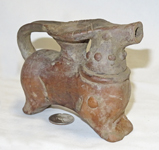
Several years after I got the two above, this one showed up and is alledged to be an original from which the reproductions may have been modelled. This one cane from the same seller, and indeed from the heirs of the same Munich collector, bought at the same time as the Celtic bull above.. The Ebay description said it is Greek pottery, a Cypriot, Ascus, Ritual Vessel dating from 800-600BC. In respone to my query the seller indicated that the collector's notes indicate it was purchased bin March 2017 from "non-professional archaeologists from Turkey, who found it near the present-day town of Tasucu, which is not far from the town of Mersim." I'm not at all sure what to think about 'non=professional archaeologists' but I guess there are legitimate such. At any rate it's very hard clay and in good condition and I'd like to believe it is as advertised. It certainly bears a very close reseblance to the reprocuctions, albei when I biught them they came with no further informaion..
|
|
|
This is a small replica of a Minoan Bull’s Head Rhyton from
Crete. From the number of postcards and replicas of it and many very similar bulls’
heads available on eBay it seems to be a popular museum piece. |
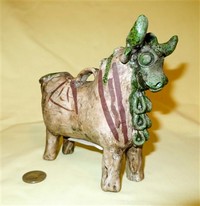 |
This is a Peruvian Torito de Pucara. Rhyton ‘purists’ would probably object
because there is no Greek or Persian heritage here, but rather a combination of Spanish and
indigenous Andean. However as noted in other places where I have displayed these
lovely bull vessels (see expecially Pery on the Places page), they were initially designed for rituals associated with the
cattle-branding ceremony, to hold a mixture of blood and chicha (corn-based beer).
Thus they certainly meet the basic (expanded) definition. They have become a very
popular souvenir of Peru, and also are often found in pairs on newly-completed roofs
of houses, bearing a bottle each of chicha and holy water.
|
 |
Here are two more Toritos, both acquired from Novica which sells products
from artisans around the world to folks like me. The large greyish one is by Walter
Jose Acosta, from the Huambo province in the Amazon region of Peru, who is
dedicated to perpetuating the beauty of Peruvian ceramic art. The little black one
is by Maribel Posso Olivares who with a friend now heads a workshop with about 12
artisans, creating ‘alasitas’ which are tiny items reflecting wishes. Novics states that its mission
is to spread happiness to both the artisans and to their customers, and their items come beautifully
(and safely) wrapped, and in the case of these two, with little dolls attached to the red bows.
|
Yet three more - the bright ones on the left were sold as Mexican cow jugs but are pretty obviously Toritos. They are wildly painted and also very light, more like some sort of plastic rather than clay. On the right is a more traitional clay one, definitely Peruvian.
|
|
The larger one here was my very first Torito, although at the time I didn't know what it was - I just thought it was a neat Mexican bull, available at a church yard sale for a nickel. The little ones came much later. They have the classic form, but just are tiny to serve as alasitas, or to appeal to tourists with small bags. They also will appear on the Miniatures page.
|
 |
Two more from Peru – the one on the right is a version of the Torito, and the
other a quite different stylized version of a bull. Its tongue very nearly covers
the hole in its nose. When my wife and I visited Peru we encountered a very large
number of marvelous old pottery figures, some quite scatological and all fanciful,
in the museums. As noted above, bulls were not native to the area so this type of
figure appears only after the Spanish conquest.
|
 |
Finally for Peru, here is a small facsimile of how the Peruvians often
display the toritos on their homes. To quote the seller who was from Cuzco “The
torito of pucara is a ceramic handicrafts of the district of Pupuja, in the province
of Azángaro, Peruvian department of Puno. It is a totemic symbol known as qonopas
(Quechua) and / or Illas (Aymara), used in Andean rituals and ceremonies of
protection, happiness and fertility in married life. In the perception of the Andean
settlers that the pair of pucará toritos on the roof is a sign of protection and
happiness in the home, it is an Andean duality that represents the husband and the
woman that represent the fusion of positive and negative energies that the
Equilibrium And the common good. At present, this piece has become a symbol of
Peruvian Andean identity. The singular finish of the toritos are imperfect figures,
of rough aspect, although they are charming and handmade in all ways. The objects
are tied with the sheepskin and the black color is because they are destined to be
buried in the day of the Pachamama the 1 of August of each year.”
|
Both of these large stylized bulls have just a single hole in the snout, and
bear a interesting resemblance to some of the ones I found on the google rhyton
images page. They’re clearly not made for cream or milk – but would serve well for
wine (or blood). The red glazed ceramic one came to me from Ontario Canada and the
only information the seller could provide is that he got it at an estate sale from
someone who had an extensive pottery collection, and that it’s most likely Blue
Mountain or CCC pottery.
|


This large brown bull with a stopper on its back seems to have 3 martini glasses on its sides. It's signed, but I sure can't decipher it. The seller said it came from Sweden, so perhaps at one point it contained aquavit, and was used for libations to Thor or Odin (or Loki or Freya or...).
|
 |
Here starts a series of cow shaped containers that likely have no ritualistic purpose, but don't
really fit in other pages of this web site. We begin with a pair of Spanish cruets from Seville, presumably designed
for oil and vinegar (and for sale to tourists). The large one with the bull on its belly is intended, I believe, for wine.
|
On the left are two wine pitchers decorated with an impressionistic bull. They're
meant to be mother and child I guess since only a Mom could love a face like that. Sharing this
section is a similarly shaped vessel from Mexico.
|
This interesting “Punter” signed pitcher comes from the workshop of fifth generation ceramicist Domingo Punter and his family (Artesiana Domingo Punter e Hijos, S.A,). located in the Plaza de Cathedral of Teruel (Aragon), a high altitude town in eastern Spain noted for its Mudejar architecture, a mix of Gothic and Islamic. I could not find a web site for them, but a number of other sites feature their pottery and tell us that the dark red clay from this region is very dense, and that their work is intended to reproduce the Spanish Romantic style of the 14c., thus the somewhat primitive designs and only the black and green colors of that period. This quite idiosyncratic cow or bull is dated ’57 and came to me from the Netherlands. The 'puckered' moith and large horns are reminiscent of other Spanish bull cruets and wine jugs, but the body and legs seem to be unique to ths family. The price on Ebay was quite low for work from the Pungter studio, but shipping made up for it.
|
This is a traditional clay piece from Cuenca, Spain. From what I can glean from a number of web
sites and a knowledgeable UK seller, it is an
example of Cuenca’s most typical pottery item, the so called "Toro Ibérico"
(Iberian Bull) which was originally created by the master potter Pedro Mercedes who
was inspired by an Iberian bull head from the 7c Moorish period which was found in
the town of Huete and is kept in the Museo de Cuenca. Apparently the modern ones became favored as
family gifts representing the spirit and courage of the Spanish or Iberian bull, a reputation gained
from bullfights. These cute little bulls proved to be very popular and have morphed into souvenirs,
as well as into vessels used - like those above - for oil and vinegar or perhaps wine.
|
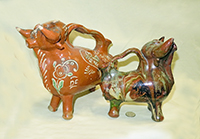 |
Here are a couple of the souvenir versions - much more gaudy than the traditional clay form. They
both have raised letters that read “Recuerdo de Cuenca” , Souvenir of Cuenca. The smaller one also
has an impressed seal on its right rump that reads “E. del Castillo Alfarero , Cuenca” and Emilio
Castillo’s ceramic studio is indeed in Cuenca Spain.
|
 |
Some potters - and some tourists - apparently got carried away. This 'Recuerdo' is downright huge
and heavy.
|
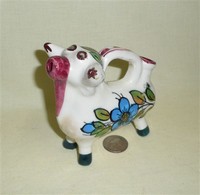 |
More reasonable in size, and much more common in the gift shops (and on ebay) are small 'Toros Iberico" like this one, suitable like the small bottle-shaped ones with bull's heads for oil and vinegar, and a bit too skimpy for wine. |
|
|
Here’s another of the same shape, this time with cats on the side,
advertising a holiday resort in Torremolinos, Costa del Sol, Spain. It was made in Spain and is
marked with a red crown over a cup with a V, over a blue wreath with
“Valdelvira” at the bottom. The popularity of the Toro Iberico has clearly spread well past Cuenca.
|
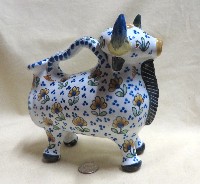 |
This brightly decorated version with bulgy yellow eyes is made of red clay and is marked for “J.
Roig, P. Espanol, Barcelona”
|
|

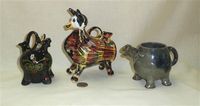
|
These small versions - some typical Iberain bull in form and others considerably more fanciful
- are likely intended to hold olive oil or something similar - but they probably have a right to be
on this page given that their shape is quite reminiscent of some of early ritualistic vessels. Then
again, for those on a Mediterranean diet, use of olive oil can indeed be considered a ritual. The
first one of these that my wife and I got was the reddish brown clay one with the earrings in the
middle of the upper picture. We purchased it in a shop in San Gimignano, Italy, in 1990. It carries
fond memories of a pleasant vacation in central Italy, and a fascinating old
town of nine towers. Great wine in the area, too! The only other one of these
that’s marked is the dark brown one on the far left of the upper picture: from Enesco, and made in
Japan. Perhaps it should be called a "Toro Nipponico". The little grey-blue cup with cow head spout
on the far right in the lower picture is hand made, and almost certainly comes from somewhere in the
US; the eBay seller was in Arizona. I conclude that the traditional Curnca Bull has indeed become
world-renowned.
|
|
Yet two more big ones for good measure
|
 |
This interesting Russian liquor dispenser came, thanks to eBay, from a seller
in Vratsa, Bulgaria.
|
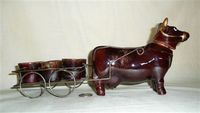 |
This bull pulling the little wagon with cups is a liquor decanter – its head
comes off for pouring.
|
 |
Here is another version of a liquor dispenser. There are some very lovely
French ones on the Faience page, but this one is quite obviously Japanese (and it
has a sticker that says so), labeled for “PAC” although it has all the
characteristics of several other cows scattered throughout that came from
Thames. Somehow I can’t imagine it holding sake. Indeed, I doubt that one like
this was ever sold in Japan – only some crazy American would ever buy something this
weird.
|
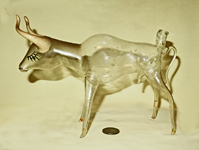 |
Some glass-blower has a sense of humor. Likely Italian? Seller made a few futile guesses at the maker but best just to say I have no idea. Pretty obvious how this one works (the shadow makes that especially clear) - and it does have 2 holes so is fully qualified for the collection. It came with cork stoppers for both the in and the out orifices - but like a suiteki, if the top fill hole is tightly pluged, he doesn't leak. Lovely eyelshes, too. I think I will use it for slivovika which is clear as well as tasty. |
|
As if the one above wasn't bad enough, try this one..., I am embarassed to say that I actually paid money for it...although it was cheap.
The only saving grace is that it does meet the 2-hole criterion, even if the fill hole is
a basket and the 'pour' hole is between its feet. I think it was intended to amuse children. |
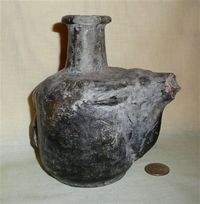 |
This is an old Chinese earthenware pot with the head of a bull or water
buffalo that the seller claimed is 17c Qing Dynasty; it’s beaten up enough to be so,
although it’s now against the law to export items from China that date from before
1911. It was most likely designed to hold water or, even more likely, soy
sauce.
|
NANDI – Hindu holy water pots and other temple cows and bulls
|
As I understand it (I get confused by Hindu deities), Nandi the white bull is Shiva’s vahana or
vehicle, the mount on which he rides. A note from the Philadelphia Museum of Art adds that “Shiva is
a great ascetic whose power emerges as contained sexual energy. Appropriately, he is accompanied by
the virile bull. An image of Nandi sits in the hall or porch of temples dedicated to Shiva, facing
into the sanctum like the primary devotee that it is.” In ancient India, he was also an independent
deity known as Nandikeshvara, the Lord of Joy, represented as a man with a bull’s head. The folks
who sold me this lovely older copper version – which comes from Jodhpur in Rajasthan – said that
these pots are used by priests to spray holy water on the devotees who come to worship at Shiva’s
shrine, or are carried by holy men to hold and disperse holy water from the Ganges. As you will
note, this Nandi arrived very carefully packaged for safety in an old tin for Kashmir Snow Beauty
Aids.
|
|
Here are two modern brass Nandi, both coming direct from India but without the fancy box.
|
|
This is a particularly nice example, with bronze head, tail, base and lid, but with a silverish body bearing an impressed Buddha plus the bull's legs and a lot of flowers and other decorations. |
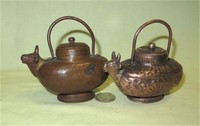 |
Here are two small nandi water pots. The one on the left with nicely inscribed marks was said to be
from Natal, but was shipped from Singapore. The copper one on the right is from India; it was very
dirty and tarnished when it arrived so I cleaned it up a bit.
|
Here are three more Nandi water pots in different configurations and types of metal, as well as
what I found out later were vessels for ghee, as explained in the next section.
|
I had thought that all these bull or cow shaped Hindu ritual vessels were models of Shiva’s bull,
used for holy water. Then the large and rather plain oval bodied ‘cow’ on the left arrived, from a US
seller. It contained a small leaflet entitled “Butter pot” that said “In India, the cow is believed
to be “close to God” and can fulfill dreams and desires. This brass cow’s head kettle is used to hold
the clarified butter, called Ghee, which fuels the holy flame that is kept lit at all time in Hindu
Temples”. As it turns out I had a few others of similar size and shape that I now believe to be
other versions of ‘cows’ not bulls, used for Ghee. They certainly are of a different shape and
character than the holy water nandis…but nonetheless because of their use in Hindu temples I believe
they belong in this part of the collection
|
 |
Straight from Ahmendabad in Gujarat, India comes this lovely brass (so said the seller) standing
nandi. Very different in shape and structure from my others, it is nonetheless designed for
holding and dispensing holy water…not through the mouth which has no hole, but rather through the
hollow horns. I don’t know if this has any ritual significance, but from my perspective it certainly
qualifies for the collection.
|
|
Here is a similar but smaller and somewhat less well crafted horn-pouring nandi. He looks a bit
dejected, but is nevertheless very cute. It’s interesting that after several years of collecting and
finding none of these, I bought this and the one above just a month or so apart. This one had a very
important feature – it cost 99 cents (plus something like 14x that for shipping)
|
|
|
Yet another variant – a copper “Shivling Holy Water Cow Face Cone” according to the London-based
seller. The add for it on eBay stated: ““All our Spiritual Products Are Spiritually activated With
Mantras & Puja’s also known as Abhisheka by our Panditji Priest without any extra charges. Ideal to
hang in temple over Shiva Linga – very auspicious to do Shiva Pooja” Naturally this sent me to
Wikipedia where I learned first that “Abhisheka, also called Abhishekam, is conducted by priests, by
pouring libations on the image of the deity being worshipped, amidst the chanting of mantras.
Usually, offerings such as milk, yogurt, ghee, honey, Panchaamrutam, sesame oil, rosewater,
sandalwood paste may be poured among other offerings depending on the type of abhishekam being
performed. This ritual is routinely performed in some Hindu and Jain temples. "Rudraabhisheka"
(Abhisheka of Rudra) is performed on Shiva lingams.” Seeking further, I also found out that “A pandit
or pundit is a scholar and a teacher, particularly one skilled in the Sanskrit language, who has
mastered the four Vedic scriptures, Hindu rituals, Hindu law, religion, music, and/or philosophy
under a Guru in a Gurukul or has been tutored under the ancient Vedic Guru-Shishya academic
tradition. The English loan word pundit is derived from it.”
|
 |
Finally, here are three open-topped Nandis – the largest and smallest came from Sunil Arts & Engg Works in Jodhpur, Rajasthan, India, and the silver colored one from a seller in the US who
presumably brought it back as a souvenir. The well crafted tiny copper Nandi was said to be 70-80
years old, and used in temples. The largest one, with a stand under its chin and with internal
ridges, was sold to me as a pot or ‘ash tray’ (which I doubt), but I have also seen an identical one
described on eBay as a Kharal, which is essentially a mortar for grinding opium and making ‘opium
water’ which is then taken through the bull’s mouth. Perhaps some kind Hindu can enlighten me – I can
only say that I’m learning, slowly, that holy cows and bulls from India can have many manifestations
and uses.
|
| |
|

